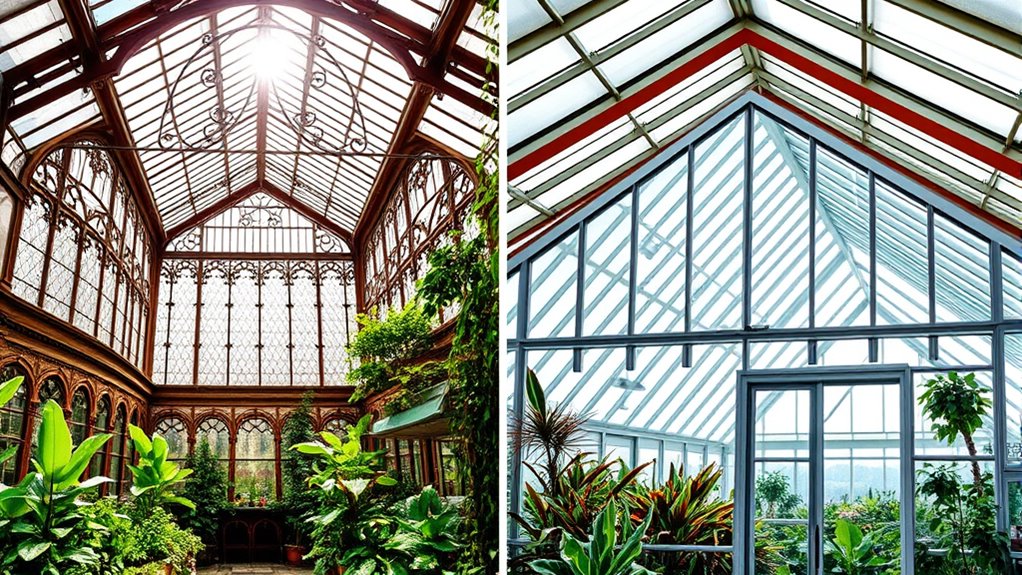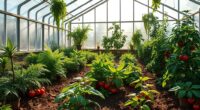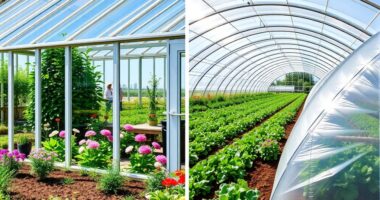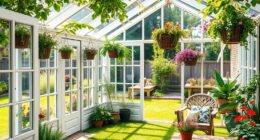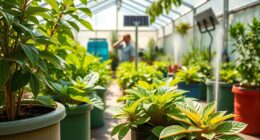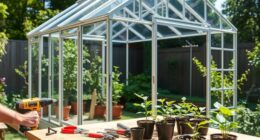Greenhouses evolved from ancient Roman innovations using oiled cloth to cultivate crops like cucumbers. During the medieval period, monasteries refined garden layouts. The Renaissance saw glass structures for exotic plants, while the Industrial Revolution made greenhouses more accessible. Modern materials like metal and plastic enhance durability and efficiency today. Innovations in technology promote sustainable practices and expand market growth. If you explore further, you’ll uncover how these changes shape today’s agricultural landscape.
Key Takeaways
- Early greenhouses emerged in the Roman Empire around 30 CE, utilizing oiled cloth and selenite for sunlight and warmth retention.
- Medieval monasteries preserved horticultural knowledge, refining garden layouts that incorporated various plant types for sustenance and medicinal use.
- The Renaissance saw the introduction of glass greenhouses in Italy, promoting exotic plant cultivation and enhancing botanical knowledge.
- The Industrial Revolution made greenhouse construction more accessible with lower glass costs and innovations like the Crystal Palace showcasing large structures.
- Modern advancements focus on sustainable practices and technology integration, driving the growth of greenhouse farming and increasing market demand.
Ancient Origins of Greenhouses
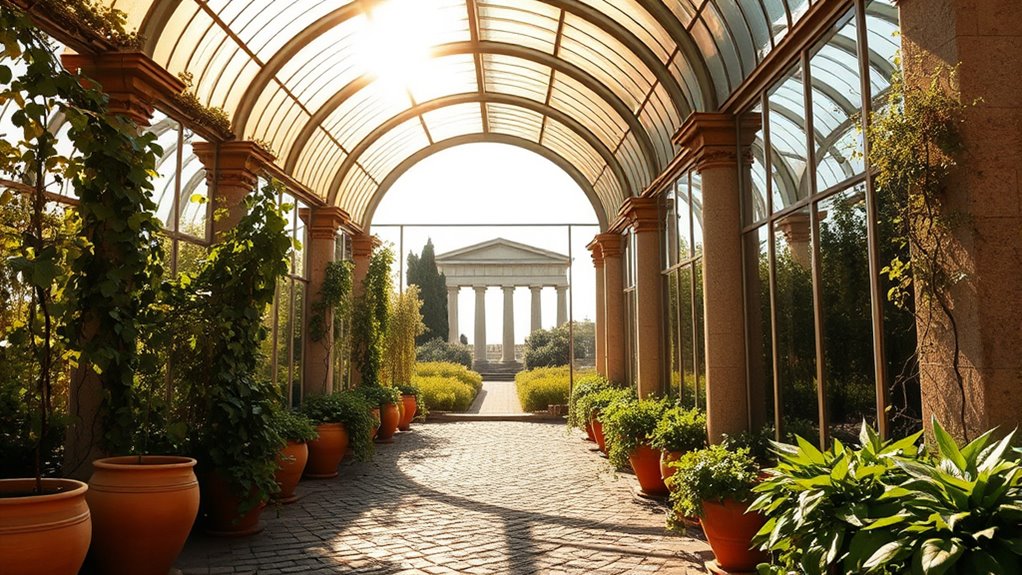
Although greenhouses as we know them today have evolved significantly, their ancient origins trace back to the Roman Empire, where innovative techniques first emerged to cultivate crops like cucumbers for Emperor Tiberius around 30 CE.
The Romans developed rudimentary greenhouses using oiled cloth or selenite for glazing, allowing sunlight to enter while maintaining warmth. They utilized wheeled carts to transport these plants, moving them into the sun during the day and indoors at night to regulate temperature.
These early structures laid the groundwork for future greenhouse designs, marking the beginning of controlled environment agriculture. By creating a stable climate, Romans enhanced agricultural productivity, setting the stage for centuries of advancements in horticulture. Additionally, the concept of estate planning for agricultural assets has roots in these early practices, ensuring that agricultural innovations were preserved and improved upon through generations.
Medieval Developments in Horticulture
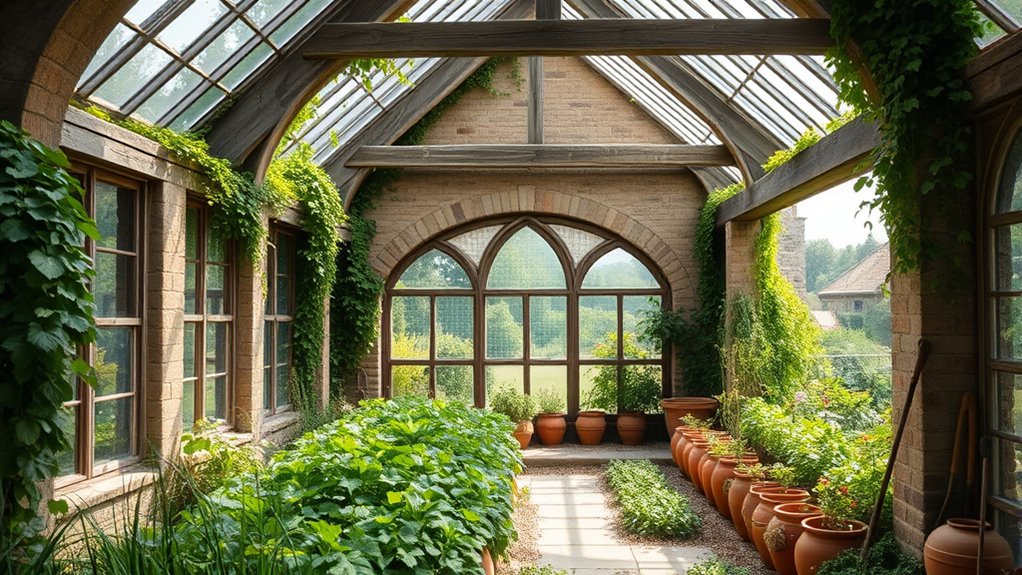
Building on the foundations laid by the Romans, medieval horticulture saw significant advancements, particularly through the influence of monasteries.
These institutions preserved agricultural knowledge and refined garden layouts, creating spaces divided into vegetable gardens, fruit trees, ornamental areas, and medicinal herb plots.
Medieval monasteries expertly refined garden layouts, blending vegetable plots, fruit trees, ornamental spaces, and medicinal herbs for holistic cultivation.
You’d find enclosed gardens that symbolized the Earthly Paradise, often featuring geometric designs and symbolic plants like roses and lilies.
Monastic gardens not only provided sustenance for monks but also cultivated medicinal herbs for local communities.
Seasonal maintenance ensured optimal growth and harvest.
While these gardens weren’t true greenhouses, walled structures offered some climate protection, paving the way for future developments in horticulture.
This period set the stage for innovations that would come in the Renaissance.
Renaissance Advancements in Greenhouse Design
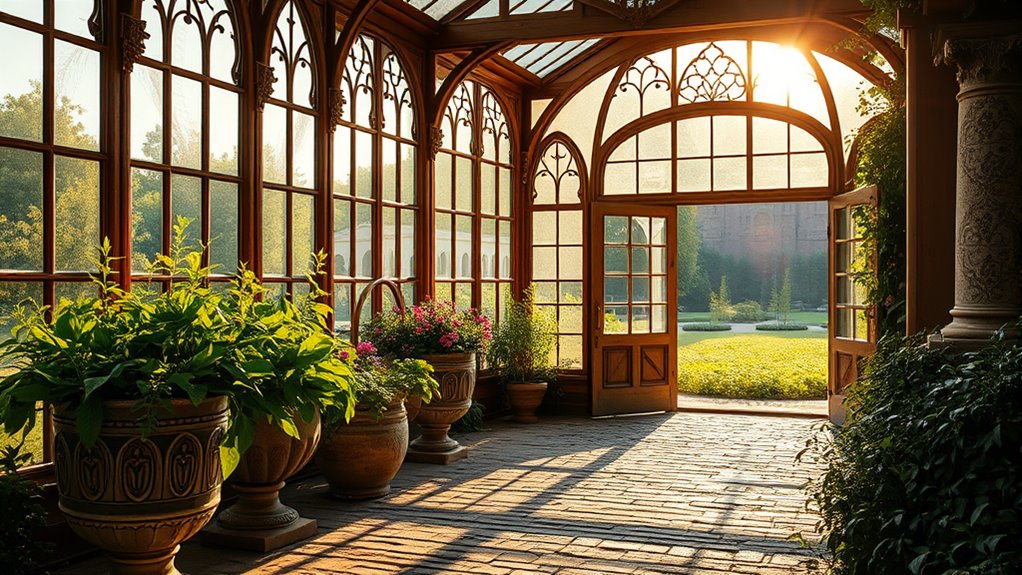
As the Renaissance unfolded, a wave of innovation transformed greenhouse design, setting the stage for modern horticulture.
You’d find early greenhouses emerging in Italy, featuring glass structures that housed exotic plants brought back by explorers. This concept quickly spread across Europe, as the wealthy developed a taste for foreign flora.
Ornamental orangeries became popular, showcasing citrus trees and symbolizing status and sophistication. Advances in glass production allowed for larger panels, enhancing light and plant growth.
Wooden frames highlighted craftsmanship and supported sophisticated designs. These greenhouses not only promoted botanical knowledge but also fostered community engagement, serving as focal points for the appreciation of horticulture and fostering experimentation with new plant species.
Innovations During the Industrial Revolution
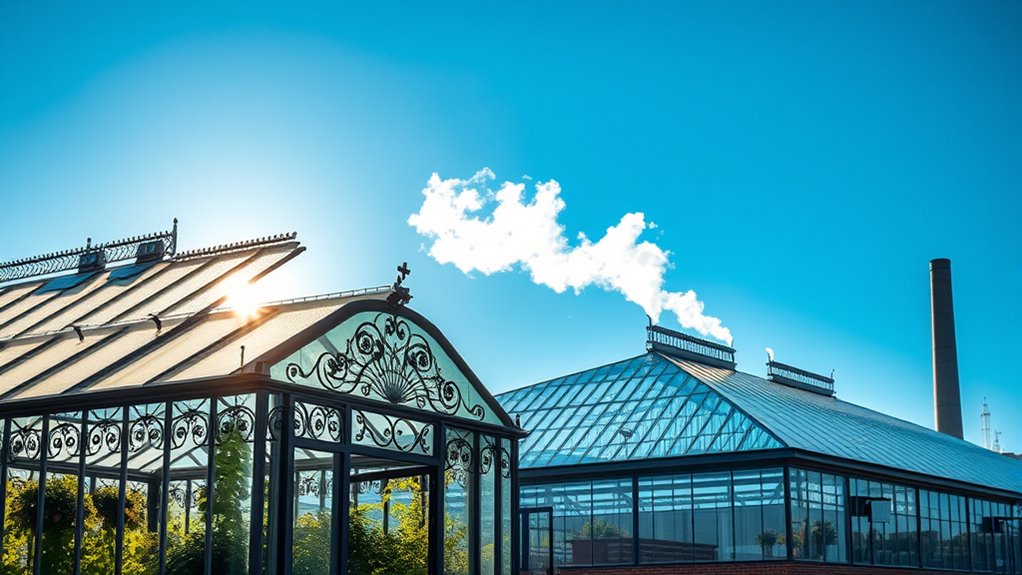
Innovations during the Industrial Revolution revolutionized greenhouse design and accessibility, making it more feasible for a broader range of people to cultivate plants. Lower glass production costs meant you could now afford to build greenhouses, expanding their use beyond just wealthy estates.
Ornate structures like the Crystal Palace became symbols of this era, showcasing the beauty and functionality of large greenhouses. Mass production of materials like metal frames allowed for faster construction, while new energy sources improved heating and cooling systems.
As urbanization grew, the demand for controlled environments surged, enabling urban agriculture to flourish. These advancements laid the groundwork for future innovations, significantly boosting agricultural capabilities and contributing to economic growth across various communities.
Modern Materials and Their Impact
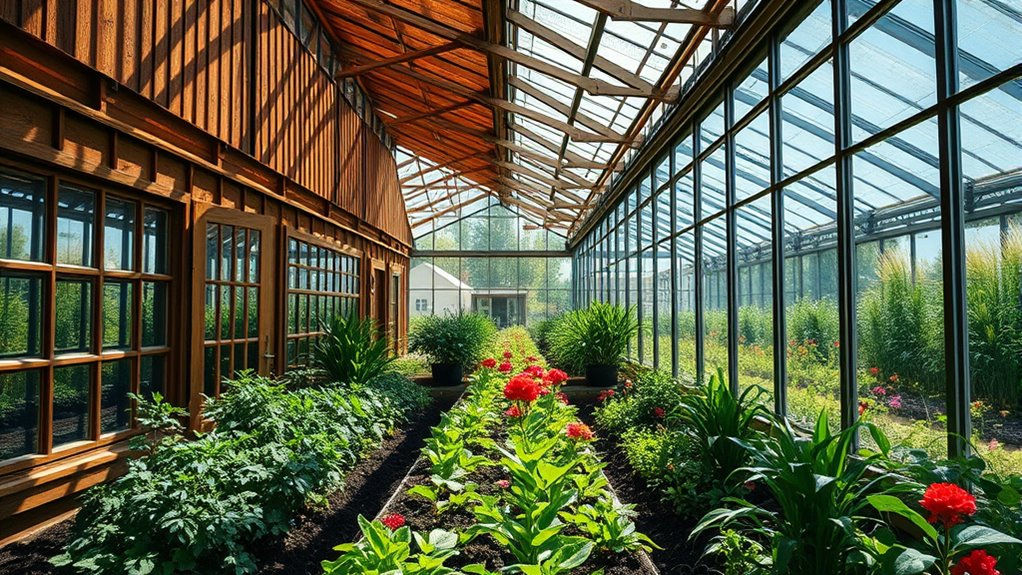
The advancements made during the Industrial Revolution set the stage for the modern materials used in today’s greenhouses.
You’ll find that wood remains popular for its natural look, while metal frames, like aluminum and galvanized steel, offer strength and corrosion resistance.
PVC frames are affordable and lightweight, perfect for smaller structures.
PVC frames offer an economical and lightweight solution, ideal for compact greenhouse designs.
When it comes to covering materials, glass provides excellent light transmission, but polycarbonate is lighter and shatter-resistant, making it a favored choice.
Concrete bases ensure stability, and interlocking tiles create easy-to-clean floors.
The impact of these materials is significant: they increase durability, improve insulation, and enhance sustainability, making greenhouses more accessible and efficient for you, the modern gardener. Additionally, an understanding of zoning laws can help you choose the best location and design for your greenhouse.
Contemporary Innovations in Greenhouse Technology
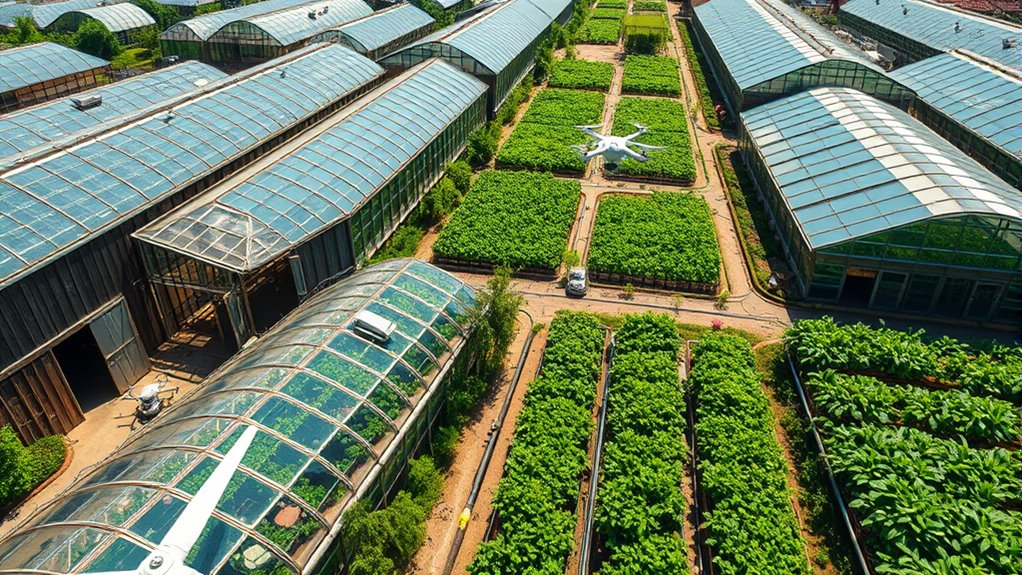
With advancements in technology, contemporary greenhouse systems have transformed how you cultivate plants, making it easier and more efficient than ever.
Wireless sensors allow you to monitor temperature, humidity, and CO2 levels in real-time. Self-sufficient irrigation systems utilize rainwater and recirculated water, minimizing waste. By supplementing carbon dioxide, you can enhance photosynthesis and potentially boost crop yields by 20%.
Advanced LED lighting mimics natural sunlight, improving energy efficiency and productivity. Automation plays a key role, with climate management systems and automated irrigation optimizing conditions based on real-time data.
Robotic pollination reduces labor needs while ensuring consistent crop production. These innovations empower you to grow healthier plants while maximizing efficiency and sustainability. Additionally, the incorporation of sustainable practices in greenhouse design helps to further enhance the environmental benefits of modern gardening techniques.
The Role of Sustainability in Greenhouse Evolution

As sustainability becomes increasingly vital in agriculture, greenhouse practices have evolved to meet both environmental and economic demands.
Historically, early innovations in greenhouses focused on climate control, relying on natural methods and materials. However, as concerns about their environmental impact grew, modern greenhouses began adopting sustainable practices. Energy efficiency evaluations are now a common practice in optimizing greenhouse operations for better performance and reduced energy consumption. The integration of renewable energy sources has become essential in minimizing the carbon footprint of greenhouse operations.
Today, you’ll find energy-efficient systems, like solar panels and geothermal heating, alongside water conservation techniques, such as drip irrigation. Organic methods replace synthetic inputs, while waste management practices convert organic waste into renewable energy. Additionally, integrating solar energy solutions into greenhouse designs can further enhance energy efficiency and reduce reliance on traditional power sources.
Closed-loop systems maximize resource efficiency, making your greenhouse operations not just productive but eco-friendly. The shift towards sustainability not only benefits the environment but also enhances your greenhouse’s economic viability in an increasingly conscious market.
Global Adoption and Future Trends in Greenhouses
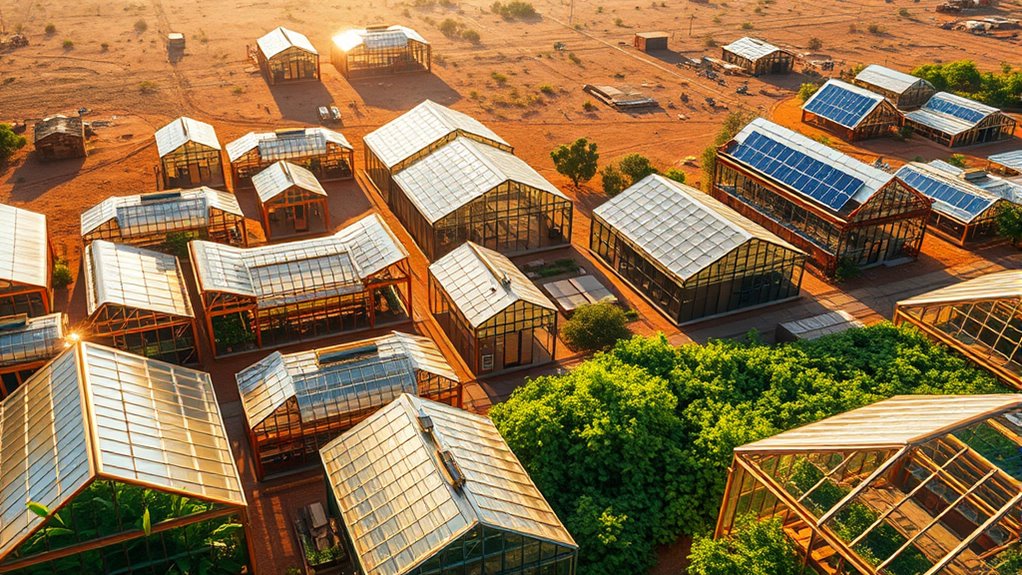
Sustainable practices in greenhouse farming have paved the way for significant global adoption and evolving trends.
The greenhouse market reached USD 25.48 billion in 2022 and is projected to hit USD 53.51 billion by 2030, with Asia Pacific leading growth at a 11.3% CAGR.
The greenhouse market is set to grow from USD 25.48 billion in 2022 to USD 53.51 billion by 2030, led by Asia Pacific.
Plastic greenhouses, holding 58% market share, remain dominant due to cost-effectiveness.
Europe’s focus on technology-driven agriculture meets its growing population’s needs, while emerging nations like India and Indonesia enhance productivity.
Innovations like AI integration and vertical agroecosystems are revolutionizing efficiency.
Post-pandemic recovery and government support further boost investment in greenhouse farming, ensuring food security and sustainable practices will continue to shape the industry’s future.
Frequently Asked Questions
What Crops Were Commonly Grown in Ancient Greenhouses?
In ancient greenhouses, you’d commonly find crops like long-fruited melons, specifically *Cucumis melo*, which were highly prized.
During the Roman era, these melons thrived year-round thanks to movable beds and transparent stone covers.
You’d also encounter vegetable melons, favored by Emperor Tiberius.
With innovative techniques for environmental control, these early greenhouses allowed you to cultivate a variety of plants, ensuring a steady supply of fresh produce despite seasonal changes.
How Did Early Greenhouses Differ From Modern Designs?
Early greenhouses differ from modern designs in several ways.
You’d notice they used wooden frames and simple glazing materials like oiled cloth, while modern ones often feature aluminum frames and advanced glass for better insulation.
Heating systems in early greenhouses relied on passive methods, whereas today’s designs incorporate automated climate control.
Furthermore, modern greenhouses cater to specific plant needs, allowing for more specialized growing environments than those early structures could provide.
What Materials Were Used in Medieval Greenhouse Construction?
Did you know that over 90% of medieval greenhouse frames were made of wood?
In medieval greenhouse construction, you’d typically find wooden frames due to their availability and low cost.
Stone or brick often formed the foundations for structural support, while some structures used glass, albeit sparingly, to let sunlight in.
Materials like mica and natural fibers were also utilized for smaller, temporary setups, showcasing early ingenuity in creating protective spaces for plants.
Who Were the Primary Users of Renaissance Greenhouses?
The primary users of Renaissance greenhouses were wealthy landowners, who saw them as status symbols, along with royal families cultivating exotic plants.
Botanical gardens utilized these structures for medicinal plant research, while horticultural enthusiasts collected rare species.
Scientists also relied on greenhouses to study plant growth and adaptation.
You’d find these greenhouses not just as functional spaces, but also as beautiful additions to estates, showcasing the owner’s wealth and knowledge of horticulture.
How Have Greenhouse Technologies Impacted Food Production Globally?
They say a stitch in time saves nine, and greenhouse technologies have certainly stitched up global food production.
By creating controlled environments, you can grow crops year-round, regardless of weather. Automated systems optimize water and nutrient delivery, boosting efficiency.
With reduced land use and waste, greenhouses support sustainability. As populations rise, these innovations help ensure food security, making it easier for you to access fresh produce while minimizing environmental impact.
Conclusion
In exploring the rich history of greenhouses, you’ve seen how these structures evolved from ancient origins to modern innovations. Did you know that today’s greenhouses can increase crop yields by up to 500% compared to traditional farming methods? This impressive statistic highlights the vital role greenhouses play in sustainable agriculture. As we look to the future, embracing these advancements can help address global food challenges while fostering a greener planet. So, let’s continue to champion this incredible evolution!
